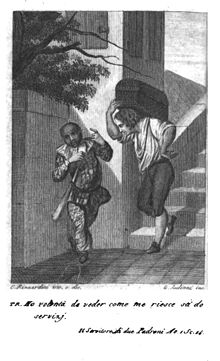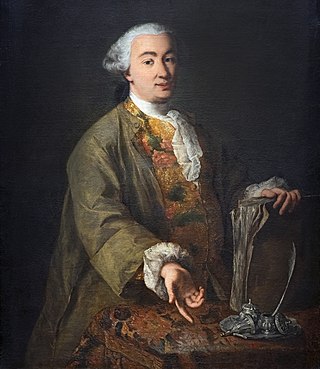
Carlo Osvaldo Goldoni was an Italian playwright and librettist from the Republic of Venice. His works include some of Italy's most famous and best-loved plays. Audiences have admired the plays of Goldoni for their ingenious mix of wit and honesty. His plays offered his contemporaries images of themselves, often dramatizing the lives, values, and conflicts of the emerging middle classes. Though he wrote in French and Italian, his plays make rich use of the Venetian language, regional vernacular, and colloquialisms. Goldoni also wrote under the pen name and title Polisseno Fegeio, Pastor Arcade, which he claimed in his memoirs the "Arcadians of Rome" bestowed on him.

Harlequin is the best-known of the comic servant characters (Zanni) from the Italian commedia dell'arte, associated with the city of Bergamo. The role is traditionally believed to have been introduced by the Italian actor-manager Zan Ganassa in the late 16th century, was definitively popularized by the Italian actor Tristano Martinelli in Paris in 1584–1585, and became a stock character after Martinelli's death in 1630.

Zanni, Zanni or Zane is a character type of commedia dell'arte best known as an astute servant and a trickster. The Zanni comes from the countryside and is known to be a "dispossessed immigrant worker". Through time, the Zanni grew to be a popular figure who was first seen in commedia as early as the 14th century. The English word "zany" derives from this character. The longer the nose on the characters mask, the more foolish the character.
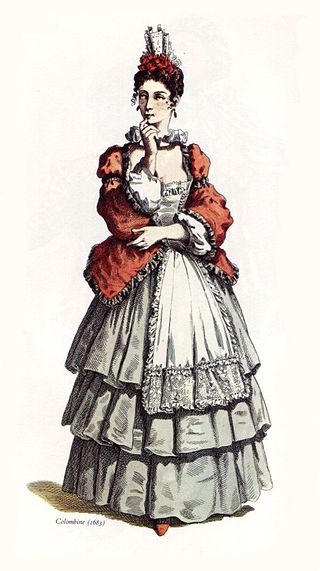
Columbina is a stock character in the commedia dell'arte. She is Harlequin's mistress, a comic servant playing the tricky slave type, and wife of Pierrot. Rudlin and Crick use the Italian spelling Colombina in Commedia dell'Arte: A Handbook for Troupes.

Innamorati were stock characters within the theatre style known as commedia dell'arte, who appeared in 16th-century Italy. In the plays, everything revolved around the lovers in some regard. These dramatic and posh characters were present within commedia plays for the sole purpose of being in love with one another, and moreover, with themselves. These characters move elegantly and smoothly, and their young faces are unmasked unlike other commedia dell'arte characters. Despite facing many obstacles, the lovers were always united by the end.
Lazzi are stock comedic routines that are associated with commedia dell'arte. Performers, especially those playing the masked Arlecchino, had many examples of this in their repertoire, and would use improvisatory skills to weave them into the plot of dozens of different commedia scenarios. These largely physical sequences could be improvised or preplanned within the performance and were often used to enliven the audience when a scene was dragging, to cover a dropped line or cue, or to delight an expectant audience with the troupe's specialized lazzi.
Vecchio is a category of aged, male characters from Italian commedia dell'arte theatre. The primary members of this group are Pantalone, Il Dottore, and Il Capitano. Pantalone and Il Dottore are the alter ego of each other: Pantalone being the decadent wealthy merchant, and Il Dottore being the decadent erudite.

Pantalone, spelled Pantaloon in English, is one of the most important principal characters found in commedia dell'arte. With his exceptional greed and status at the top of the social order, Pantalone is "money" in the commedia world. His full name, including family name, is Pantalon de' Bisognosi, Italian for "Pantalone of the Needy".

Harlequinade is an English comic theatrical genre, defined by the Oxford English Dictionary as "that part of a pantomime in which the harlequin and clown play the principal parts". It developed in England between the 17th and mid-19th centuries. It was originally a slapstick adaptation or variant of the commedia dell'arte, which originated in Italy and reached its apogee there in the 16th and 17th centuries. The story of the Harlequinade revolves around a comic incident in the lives of its five main characters: Harlequin, who loves Columbine; Columbine's greedy and foolish father Pantaloon, who tries to separate the lovers in league with the mischievous Clown; and the servant, Pierrot, usually involving chaotic chase scenes with a bumbling policeman.
Il Dottore, commonly known in Italian as Dottor Balan or simply Balanzone is a commedia dell'arte stock character, in one scenario being an obstacle to young lovers. Il Dottore and Pantalone are the comic foil of each other, Pantalone being the decadent wealthy merchant, and Il Dottore being the decadent erudite. He has been part of the main canon of characters since the mid-16th century.

L'amour des trois oranges, Op. 33, is a 1921 satirical French-language opera by Sergei Prokofiev. He wrote his own libretto, basing it on the Italian play L'amore delle tre melarance, or The Love for Three Oranges by Carlo Gozzi, and conducted the premiere, which took place at the Auditorium Theatre in Chicago on 30 December 1921.
The Venetian Twins is a 1747 play by Carlo Goldoni, based on Plautus's Menaechmi.

Pedrolino is a primo ("first") Zanni, or comic servant, of the commedia dell'arte; the name is a hypocorism of Pedro (Peter), via the suffix -lino. The character made its first appearance in the last quarter of the 16th century, apparently as the invention of the actor with whom the role was to be long identified, Giovanni Pellesini. Contemporary illustrations suggest that his white blouse and trousers constituted "a variant of the typical Zanni suit", and his Bergamasque dialect marked him as a member of the "low" rustic class. But if his costume and social station were without distinction, his dramatic role was certainly not: as a multifaceted first Zanni, his character was—and still is—rich in comic incongruities.
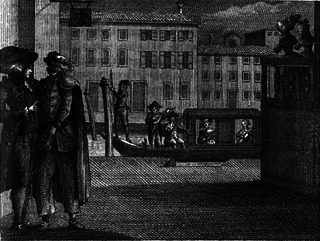
The Liar is a comedy by Carlo Goldoni. It was written as part of Goldoni's fulfilment of a boast that he had inserted into the epilogue to one of his plays that for the next season he would write sixteen comedies. The Liar, along with the fifteen other comedies, was staged in the 1750-51 season at the Teatro San Angelo in Venice. It draws on commedia dell'arte conventions and stock characters.
Le Médecin volant is a French play by Molière, The date of its actual premiere is unknown, but its Paris premiere took place on 18 April 1659. Parts of the play were later reproduced in L'Amour médecin, and Le Médecin malgré lui. It is composed of 15 scenes and has seven characters largely based on stock commedia dell'arte roles.
Antonio Sacchi (1708–1788) was an Italian improvisational actor, renowned for his performance as the Commedia dell'arte stock character Truffaldino. Sacchi's lasting influence was in requesting playwright Carlo Goldoni to provide a dramatic structure to his improvised routines, resulting in plays such as Truffaldino's 32 Mishaps (1738–40), Truffaldino's Son Lost and Found (1746), and the masterpiece A Servant of Two Masters (1745–53), which serve as the best permanent record of this impromptu and momentary art form. Sacchi toured throughout Europe with his own Commedia troupe from 1738 to 1753, and both David Garrick and Casanova spoke highly of his talents.

Commedia dell'arte was an early form of professional theatre, originating from Italian theatre, that was popular throughout Europe between the 16th and 18th centuries. It was formerly called Italian comedy in English and is also known as commedia alla maschera, commedia improvviso, and commedia dell'arte all'improvviso. Characterized by masked "types", commedia was responsible for the rise of actresses such as Isabella Andreini and improvised performances based on sketches or scenarios. A commedia, such as The Tooth Puller, is both scripted and improvised. Characters' entrances and exits are scripted. A special characteristic of commedia is the lazzo, a joke or "something foolish or witty", usually well known to the performers and to some extent a scripted routine. Another characteristic of commedia is pantomime, which is mostly used by the character Arlecchino, now better known as Harlequin.
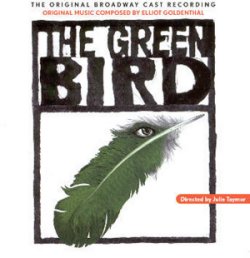
The Green Bird is a 1765 commedia dell'arte play by Carlo Gozzi. It is a sequel to The Love of Three Oranges. The main plot of The Green Bird has several similarities with the widespread tale The Dancing Water, the Singing Apple, and the Speaking Bird.
Commedia dell'arte masks are a type of mask worn by performers of the Italian form of theatre, Commedia dell'arte. Masks are an integral part of the performance, and each character wears a particular mask design. All masks were originally leather but are now more commonly made of neoprene. They are an extension of the actors and their costumes, hair, and accessories. The masks create an entirely different face for the people wearing them. Masks in Commedia dell'arte speak of the types of characters that each represents, saying that they are an unchanged type.

Truffaldino from Bergamo is a 1976 Soviet two-part television musical film directed by Vladimir Vorobyov, based on the play Servant of Two Masters by Italian writer Carlo Goldoni and featuring music by Alexander Kolker. The film follows a commedia dell'arte format about the quick-witted Harlequin Truffaldino as he is caught up in a love story between a Turinese fugitive and his lover.
